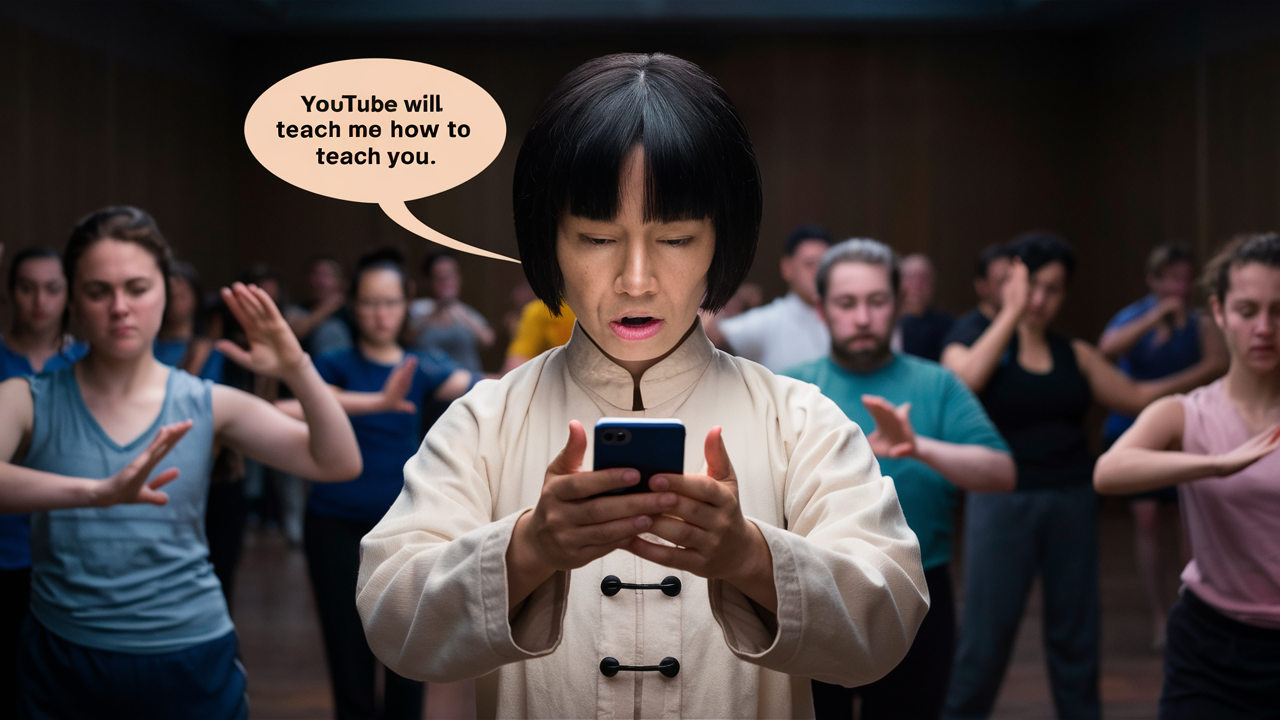Welcome to the dojo of digital days, where the ancient art of Kung Fu meets the modern marvel of YouTube tutorials!
In this post, we’ll kick into why having a coach or teacher is crucial, even if you think you’ve mastered the art through your screen. Plus, we’ll sneak in some classic Kung Fu stretches to get your blood flowing before you take on the day—because who wouldn’t want to start their mornings feeling like Bruce Lee?
The Hidden Dragon
Why Your YouTube Shifu Master Isn’t Enough
Ah, YouTube—the university of the people. Where else can you learn quantum physics in your pyjamas or master the art of sourdough from a baker in San Francisco? But when it comes to martial arts such as Tai Chi and Qigong, relying solely on YouTube can be like trying to learn swimming by watching a fish. Sure, you’ll get the moves, but will you really be water-ready?
When Your Doctor, Tai Chi, Qigong and Yoga Teacher Both Have the Same Teacher: YouTube!
Ever found yourself in a twisty situation, wondering if your doctor or yoga teacher might secretly be YouTube-certified? Welcome to the brave new world where “YouTube University” is seemingly churning out professionals from all fields! Let’s dive into the hilariously concerning phenomenon of Doctors, Tai Chi, Qigong and Yoga Teachers Learning from YouTube, because who needs years of expensive education when you have free Wi-Fi?
The YT (YouTube-Trained) Tai Chi, Qigong and Yoga Teacher
On the flip side, let’s not underestimate the power of a good Tai Chi, Qigong, and Yoga sessions led by someone whose guru might just be a YouTube algorithm. There’s something uniquely 21st-century about learning ancient practices from digital clips. While traditional Tai Chi, Qigong, and Yoga teachers might learn from sifu masters and meditate under masters in the Himalayan caves, our modern YT-certified instructors meditate on buffering speeds.
And why not? If you can learn to bake sourdough bread or change a tyre from a YouTube video, why not learn the sacred arts of Tai Chi, Qigong and Yoga and throw in a medical degree or two along the way? Just hope that your downward dog isn’t based on a video from a well-meaning yet misinformed 12-year-old enthusiast whose previous tutorial was on Minecraft hacks.

Here’s the scoop: many teachers on YouTube are fantastic, but they often hold back the secret sauce. Why? Because true mastery comes from practice and feedback, something your laptop can’t provide. Imagine learning a spinning kick without knowing if your form is more ‘dancing flamingo’ than ‘fierce dragon’—that’s where a real-life coach steps in!
Real Coaches, Real Progress
A coach or teacher doesn’t just teach; they guide, correct, and inspire. Ever tried to correct your posture via video? It’s like trying to cut your own hair using your shadow. Coaches see what you can’t and tweak your movements just right, helping you avoid the rookie mistake of ‘YouTube elbow’ or ‘DIY black belt syndrome’.

The Common Ground: Confidence or Overconfidence?
Both your doctor, Tai Chi, Qigong, and Yoga teacher, armed with snippets of online wisdom, share a dangerous weapon: overconfidence. There’s a thin line between a confidently held scalpel, moving gracefully, and a confidently held yoga pose, both learned via a 5-minute clip sandwiched between ads for hair loss treatments and miracle wrinkle creams.
The Takeaway: Always Check the Credentials!
So next time you visit either a doctor, Tai Chi, Qigong, or a Yoga class, it might be worth asking where they got their certification. If the answer is “YouTube,” you have full permission to laugh (or cry)—maybe both. And remember, just because you can learn something on YouTube, doesn’t always mean you should!

The Warm-Up: Your Morning Cup of Kung Fu
Now, let’s talk warm-ups. A good warm-up is to your training what coffee is to your morning—absolutely essential. Jumping into intense training without prepping your muscles is like sending a knight into battle with pool noodles instead of armour. Not a good look.
How Long Should You Warm-Up?
The golden rule? At least 30 to 45 minutes of stretching before you start training, regardless of intensity,. This isn’t just about flexing muscles; it’s about waking them up, increasing blood flow, and reducing the risk of injury. And for those ready to embrace their inner Kung Fu warrior, why not go for a full 60-minute stretch session?

Classic Kung Fu Stretches: Your New Morning Ritual
To help you start your day with vitality, we’re sharing some classic Kung Fu stretching routines. Think of it as yoga with a hint of dragon spirit. These stretches aren’t just effective—they’re designed to align your energy and prepare you for whatever the day throws your way, be it a marathon meeting or an actual marathon.
Wrapping Up: Beyond the Screen
Remember, while YouTube is a great resource, it’s not a complete dojo or studio. A real coach can provide the context behind each move and the personalised feedback that helps you grow. Combine the wisdom of video tutorials with the expertise of live coaching, and you’re on your way to true martial arts and yoga mastery.
So, lace up your training shoes, roll out your mat, and remember: every great warrior starts with a stretch. Happy training!
Happy Training from the
1MindBodyFitness Team

